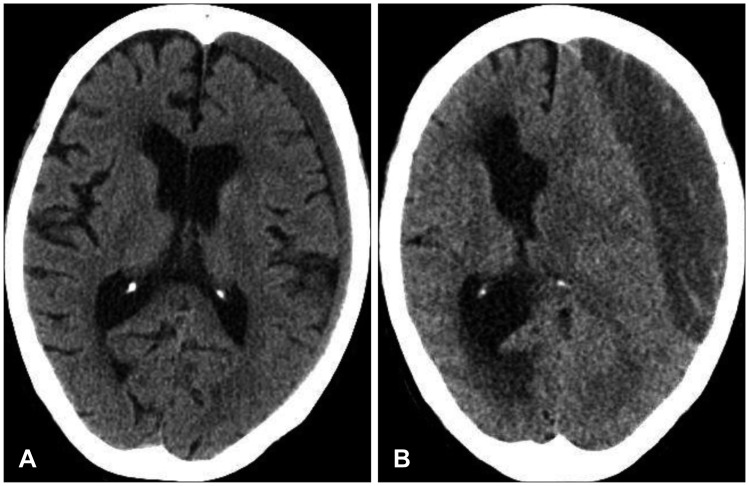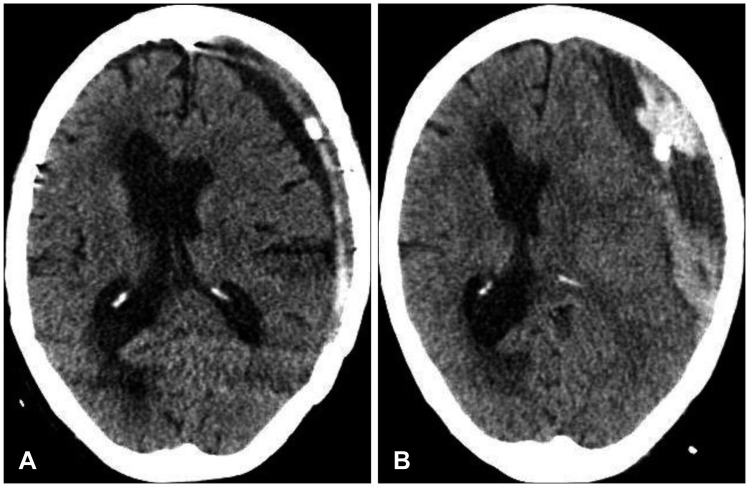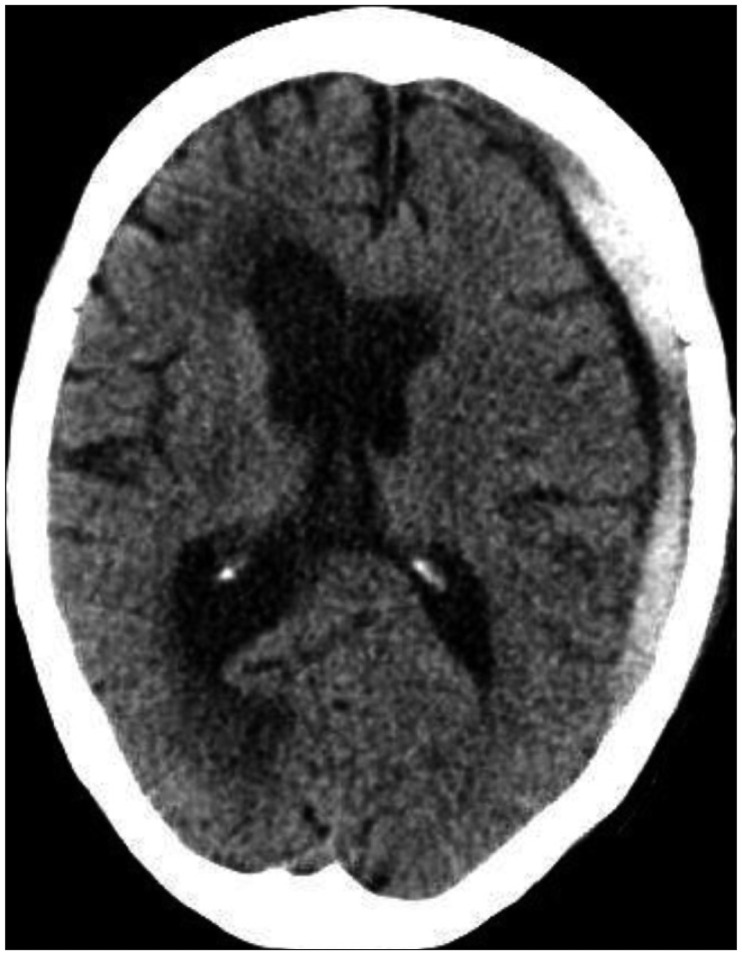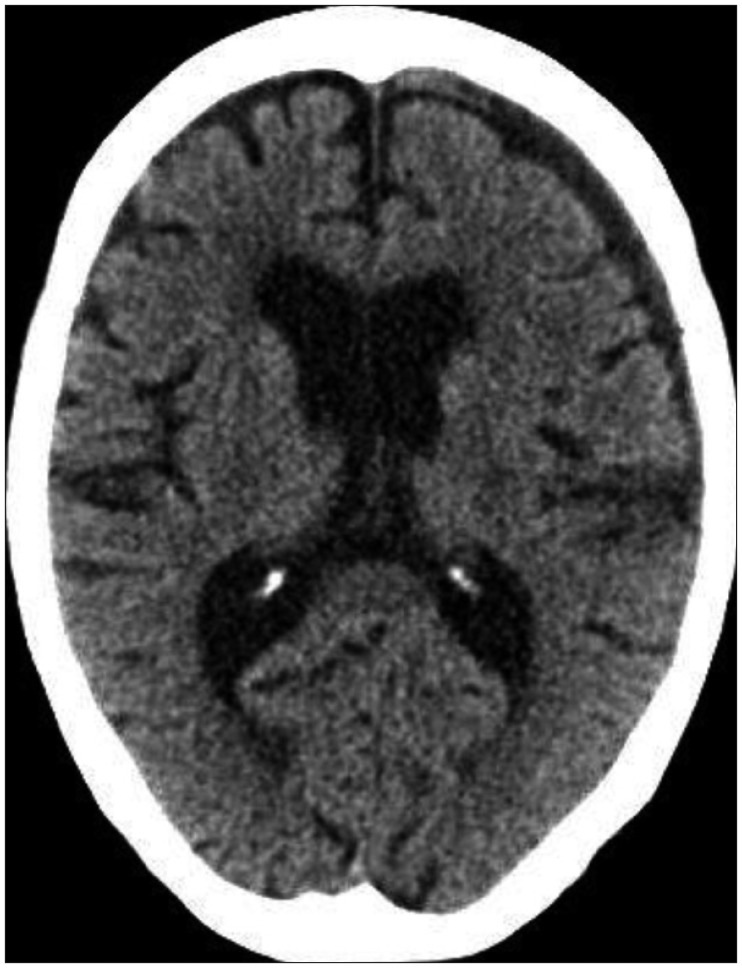Korean J Neurotrauma.
2018 Oct;14(2):142-145. 10.13004/kjnt.2018.14.2.142.
Burr Hole Drainage with Urokinase Irrigation for the Treatment of Acute Subdural Hematoma: A Case Report
- Affiliations
-
- 1Department of Neurosurgery, Chungnam National University Hospital, Chungnam National University Medical School, Daejeon, Korea. swonchoi@cnuh.co.kr
- KMID: 2424328
- DOI: http://doi.org/10.13004/kjnt.2018.14.2.142
Abstract
- We describe the case of a patient with an acute subdural hematoma (SDH) that was removed using urokinase irrigation after burr hole trephination in a limited situation where craniotomy was not possible. A 90-year-old woman was admitted to our hospital with a stuporous mental status. Computed tomography (CT) scans revealed a chronic SDH, and a burr hole procedure was performed. The patient's postoperative progression was good until the third day after surgery when we found that the acute SDH had increased on CT scans. The patient's guardian refused further surgery, and thus we drained the blood from the hematoma by injecting urokinase through a drainage catheter. We used urokinase for two days, and removed the catheter after confirming via CT scans that the hematoma was almost alleviated. The patient recovered gradually; she was discharged with few neurological deficits.
Keyword
MeSH Terms
Figure
Reference
-
1. Arginteanu MS, Byun H, King W. Treatment of a recurrent subdural hematoma using urokinase. J Neurotrauma. 1999; 16:1235–1239. PMID: 10619201.
Article2. Bullock MR, Chesnut R, Ghajar J, Gordon D, Hartl R, Newell DW, et al. Surgical management of acute subdural hematomas. Neurosurgery. 2006; 58:S16–S24. PMID: 16710968.
Article3. Cagetti B, Cossu M, Pau A, Rivano C, Viale G. The outcome from acute subdural and epidural intracranial haematomas in very elderly patients. Br J Neurosurg. 1992; 6:227–231. PMID: 1632921.
Article4. Chen X, Chen W, Ma A, Wu X, Zheng J, Yu X, et al. Frameless stereotactic aspiration and subsequent fibrinolytic therapy for the treatment of spontaneous intracerebral haemorrhage. Br J Neurosurg. 2011; 25:369–375. PMID: 20874455.
Article5. Cho JH, Kang DG, Lee CR, Kim SC. The use of urokinase in treatment of epidural hematoma. J Korean Neurosurg Soc. 1992; 21:1080–1087.6. Gaberel T, Montagne A, Lesept F, Gauberti M, Lemarchand E, Orset C, et al. Urokinase versus alteplase for intraventricular hemorrhage fibrinolysis. Neuropharmacology. 2014; 85:158–165. PMID: 24846802.
Article7. Izumihara A, Yamashita K, Murakami T. Acute subdural hematoma requiring surgery in the subacute or chronic stage. Neurol Med Chir (Tokyo). 2013; 53:323–328. PMID: 23708224.
Article8. Jacobs DG. Special considerations in geriatric injury. Curr Opin Crit Care. 2003; 9:535–539. PMID: 14639075.
Article9. Kenning TJ, Dalfino JC, German JW, Drazin D, Adamo MA. Analysis of the subdural evacuating port system for the treatment of subacute and chronic subdural hematomas. J Neurosurg. 2010; 113:1004–1010. PMID: 20509728.
Article10. Liu W, Ma L, Wen L, Shen F, Sheng H, Zhou B, et al. Drilling skull plus injection of urokinase in the treatment of epidural haematoma: a preliminary study. Brain Inj. 2008; 22:199–204. PMID: 18240049.
Article11. Lu T, Guan J, An C. Preoperative trepanation and drainage for acute subdural hematoma: Two case reports. Exp Ther Med. 2015; 10:225–230. PMID: 26170939.
Article12. Modesti LM, Hodge CJ, Barnwell ML. Intracerebral hematoma after evacuation of chronic extracerebral fluid collections. Neurosurgery. 1982; 10:689–693. PMID: 7110541.
Article13. Mori K, Maeda M. Surgical treatment of chronic subdural hematoma in 500 consecutive cases: clinical characteristics, surgical outcome, complications, and recurrence rate. Neurol Med Chir (Tokyo). 2001; 41:371–381. PMID: 11561347.
Article14. Rohde V, Uzma N, Rohde I, St Clair E, Samadani U. Fibrinolytic therapy versus craniotomy for anticoagulant-associated intracerebral hemorrhage. Clin Neurol Neurosurg. 2009; 111:518–522. PMID: 19297083.
Article15. Son S, Yoo CJ, Lee SG, Kim EY, Park CW, Kim WK. Natural course of initially non-operated cases of acute subdural hematoma: the risk factors of hematoma progression. J Korean Neurosurg Soc. 2013; 54:211–219. PMID: 24278650.16. Takeuchi S, Takasato Y, Otani N, Miyawaki H, Masaoka H, Hayakawa T, et al. Subacute subdural hematoma. Acta Neurochir Suppl. 2013; 118:143–146. PMID: 23564121.
Article17. Yoon SM, Lee KS, Lee JH, Doh JW, Bae HG, Yun IG. Surgical outcome following evacuation of traumatic intracranial hematomas in the elderly. J Korean Neurosurg Soc. 2003; 33:477–482.
- Full Text Links
- Actions
-
Cited
- CITED
-
- Close
- Share
- Similar articles
-
- Burr hole drainage using urokinase for treatment of subacute subdural hematoma
- Delayed Onset Acute Subdural Hematoma after Burr Hole Drainage in a Patient with Chronic Subdural Hematoma and Liver Cirrhosis
- Cerebellar Hemorrhage after Burr Hole Drainage of Supratentorial Chronic Subdural Hematoma
- Comparison of Outcomes and Recurrence in Chronic Subdural Hematoma Patients Treated by Burr-Hole Drainage with or without Irrigation
- Evolution of Chronic Subdural Hematoma based on Brain CT findings and Appropriate Treatment Methods





